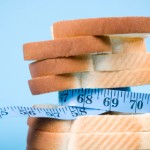Whether it’s a slice of crusty bread, crunchy cereal or a bowl of your favourite pasta, nothing spells comfort as much as carbs. But dietary carbohydrates have taken a bad rap ever since the Atkins diet revolution made headlines.
And newer, more moderate ‘low-carb’ diet plans encourage you to virtually eliminate foods from the grains and starches food group, particularly in the introductory phases of a weight loss plan. But we love our carbohydrates! And we think it’s time you felt free to love your carbs again.
Categorize Your Carbs
Many low-carb diets urge you to virtually eliminate foods from the grains and starches food group, especially in the initial stages of weight loss. But Canada’s Food Guide maintains its 6-8 serving recommendation for the Grain Products food group.
That’s because not all carbohydrates are created equal. Pastries, store-bought snacks and cookies are carbs but they would not be considered part of the Grain Products food group. They would classify as ‘other’ foods due to the high content of sugar and fat.
 Also, our supermarkets and pantries are flooded with refined grains. These include many white pasta dishes, refined crackers, pretzels, breads, snack cakes and cereals.
Also, our supermarkets and pantries are flooded with refined grains. These include many white pasta dishes, refined crackers, pretzels, breads, snack cakes and cereals.
Refined grains are produced by milling whole grain into flour to create a fine texture and improve shelf life. Milling removes the germ and the bran, and only the endosperm (inside portion) remains intact. Although several nutrients are added back to create an “enriched grain,” refined grains contain much less fibre and fewer nutrients than whole grains (especially if they’re high in solid fats and added sugars). Since they are digested more quickly, they tend to be much less filling and can spike our blood sugars. Limiting refined grains in your diet is a good idea, and your pancreas will thank you!
But whole grains are an entirely different story. Whole grains contain all the natural nutrients and essential parts of the grain seed including the bran, germ, and endosperm. They are a rich source of fibre, B vitamins—including folate, which plays a role in heart health, and thiamin and niacin, both of which help the body burn energy. Whole grains are also rich in minerals such as iron and magnesium, which may help lower blood pressure.
A recent study published in Nutrition Research found that adults who consumed the most whole grains had the lowest body mass index and waist circumference. In addition, emerging evidence shows that whole grain consumption is associated with a reduced incidence of type 2 diabetes.
Examples of whole grains include 100% whole wheat, whole oats, wheat berries, wild rice, brown rice, barley millet, amaranth, sorghum, triticale and quinoa.
Portion It Out
A big bowl of whole grain pasta or brown rice is a good way to get started on your recommended 6-8 servings, right? It sure is, if you want all of your servings in one sitting.
A typical bowl of pasta is about 3-4 cups. A serving of grains is only ½ cup. So your one pasta portion ends up being your daily 6-8 servings of grains. With the portion distortion we are surrounded by, no wonder we start to see these foods as fattening!
Here are some typical serving sizes:
The Grain Group
| 1/2 cup cooked rice | size of a tennis ball |
| 1 whole-grain pancake (1 ounce or 5″) | compact disc (CD) |
| 1 piece of cornbread (2 ounces) | bar of soap |
| 1 slice of bread (1 ounce) | audiocassette tape |
| 1 cup of pasta/spaghetti (1/2 cup) | a tightly clenched fist |
| 1 cup of cereal flakes (1 ounce) | a fist |
The bottom line is that there is no need to eliminate an entire food group from your menu. Practicing label reading, product selectiveness and portion control can help you reap the health benefits of grains without breaking your calorie, fat or sugar bank.
Barley-Stuffed Artichokes Recipe
Ingredients
- 1/2 cup pearl barley or whole grain barley
- 1-1/2 cups water
- 4 large artichokes
- 1 teaspoon salt
- 1/3 cup chopped cucumber
- 1/3 cup chopped red bell pepper
- 1/3 cup chopped almonds, toasted
- 1/4 cup finely sliced green onion
Dressing
- 1/4 cup olive oil
- 2 tablespoons red wine vinegar
- 1 tablespoon white wine vinegar
- 1 tablespoon Dijon-style mustard
- 1 teaspoon granulated sugar
- 1/2 teaspoon ground black pepper
- 1/4 teaspoon salt
- 3 ounces feta cheese, crumbled
Makes 4 entrée servings.
Per serving:
- calories 433
- protein 15g
- fat 25g
- carbohydrates 43g
- cholesterol 19mg
- fibre 15g
- sodium 1216mg
Instructions
- In small saucepan with lid bring water to a boil. Add barley and return to boil.
- Reduce heat to low, cover and cook 45 minutes or until barley is tender and liquid is absorbed. If using whole grain barley, increase cooking time to 50-55 minutes and pour off any unabsorbed liquid after cooking. Set aside.
- Rinse artichokes. Cut off stems at base and remove small bottom leaves. Stand artichokes upright in deep saucepan, just large enough to hold snuggly. Add salt and 2 to 3 inches boiling water to artichokes. Cover and boil gently for 35 to 45 minutes or until artichoke bases can be pierced easily with fork. (Add more boiling water if necessary.)
- Remove artichokes from saucepan; turn upside down to drain and cool. When cool, gently spread artichoke leaves to reveal centre cone of leaves. Pull out centre cone; discard. Scrape out any purple-tipped leaves and fuzz from each artichoke centre; discard.
- Combine cooked barley, cucumber, bell pepper, almonds and green onion in medium bowl. Mix together dressing ingredients; toss with barley mixture. Refrigerate barley for 30 minutes.
- Spoon equal amounts of chilled barley mixture into centres of artichokes and serve.
